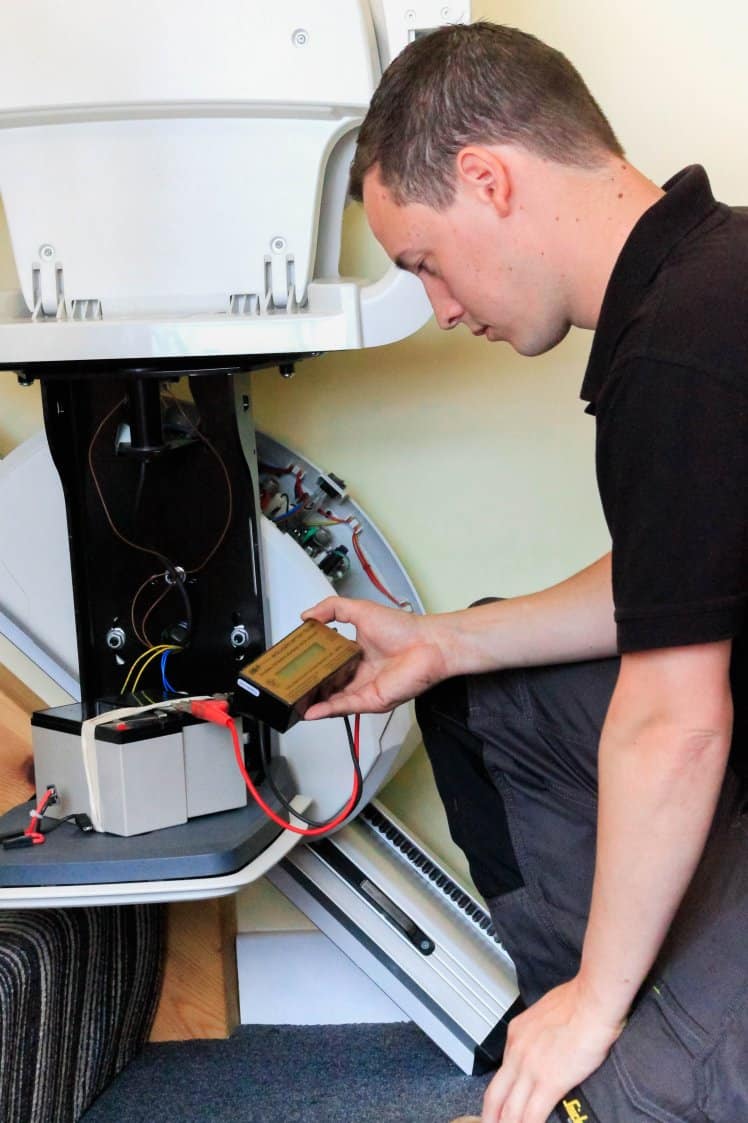
When you buy a stairlift outright, you may be spending thousands of pounds, (more information can be found in our how much is a stairlift article). Therefore, you’ll want an idea of how long it may last.
It’s difficult to accurately predict how long a stairlift will last because there are a lot of contributing factors to take into account. However, as a general observation manufacturers usually suggest an average lifespan of around 7-10 years. Although we have known some models we stock to have even gone on to last 15 to 20 years! Models that are not well looked after properly do not last as long, maybe around 3-5 years, which is why we recommend you to have your life serviced regularly by a professional.
Having a stairlift is just like having a car, if you maintain it regularly and treat it with care it should last you for a long time.
What can affect the lifespan of your stairlift?
- The quality of your product
- The weight of the user
- How you treat your stairlift
- Having your stairlift serviced
1) The Quality of your Product
It’s true that you get what you pay for. That old saying buy cheap, buy twice definitely applies to stairlifts. Buying a good quality product will last you for some years to come.
You can buy new models and second-hand models. When buying second-hand it’s advisable to check what the age of the lift is. Second-hand models that have been factory reconditioned properly (parts checked and worn parts replaced with new ones) will last longer than ones that haven’t. We recondition all our second-hand models so they will last as long as possible.
Another factor to consider is that technology in the stairlift industry moves on and as newer models come to the market, manufacturers discontinue their older models. There’s no way know of knowing how long a stairlift model will be on sale for before it is replaced; some models have been sold for over 20 years with periodic updates and some models have been replaced after 5 years. There are no predicted time limits or lengthy notice periods as to when models are likely to change.
Usually, in the UK, manufacturers commit to providing and retailing spare parts for their discontinued models for 5 – 7 years. After this time you would possibly be reliant on independent stairlift companies having stocks of spare parts should you need any.
Rarely, a manufacturer may be bought out by another. This sometimes causes models to be dropped from a product range when it is not economically viable to produce those specific models. Production would stop and maybe spare parts supply will stop too. Again that’s where an independent company may be able to help with your maintenance and repairs.
2) The Weight of the User
Every lift has a weight limit, or in our technical language, a “safe working load”. The sticker on the carriage of the lift will tell you the weight limit. If you’ve not bought one yet, the weight limit should be on the brochure. Although products are safety tested to much more than the safe working load, it’s not advisable to go over the weight limit.
So let’s say you buy a product that has a weight limit of 19 stone and you are 18.5 stone. Then, after you’ve have the lift for 6 months, you go over the 19 stone mark. What will happen? Sometimes the lift detects the weight and will cut out and stop working. Sometimes the lift carries on but this will put excessive pressure on the mechanics of the lift, meaning it will wear out quicker than you would normally expect. If you exceed the weight limit, you shouldn’t really use it.
That’s why, when buying a stairlift, you should take into account the weight limit of the model when which to choose. Should you be close to the weight limit on one model, perhaps choosing one with a higher weight capacity will last longer.
3) How you Treat your Stairlift
If you don’t look after your product, it will not look after you. We have seen lifts that have not been treated with care and subsequently don’t last very long.
You should always treat your lift with care, use it correctly and follow the manufacturer’s user manual. You should be supplied with one of these on purchase. Your product should be kept clean and in good condition. A quick wipe over of the track and chair with a damp cloth once a week will be fine and will prevent dust and pet hair build-up. These will end up in your machine and clog up the insides of your carriage. Don’t grease or WD40 the rack on the rail, this will have the opposite effect of what you are trying to achieve and can cause damage. You should also service your lift annually.
4) Having your Stairlift Serviced

How often should you service your stairlift? If you don’t have a service, your lift will not last as long as if it had been safety checked. Your lift should normally be serviced annually but if it is under heavy usage then it’s a good idea to do this every 6 months.
During a service, a good stairlift engineer will:
- clean your lift down – the rail, chair and carriage
- lubricate whatever parts are necessary depending on the model you have
- check all the safety circuits are working correctly
- ensure all the bolts are tightened – over time they may become loose
- check working parts for signs of damage and excessive wear and tear
- check your batteries to make sure they are holding the right charge
The service should always be done by a qualified stairlift engineer who is trained on your product.
How long do Stairlift Batteries last?
See our new article – the ultimate guide to stairlift batteries
Want to find out more about servicing? Take a look at our article, Why Should I have a Stairlift Service?









